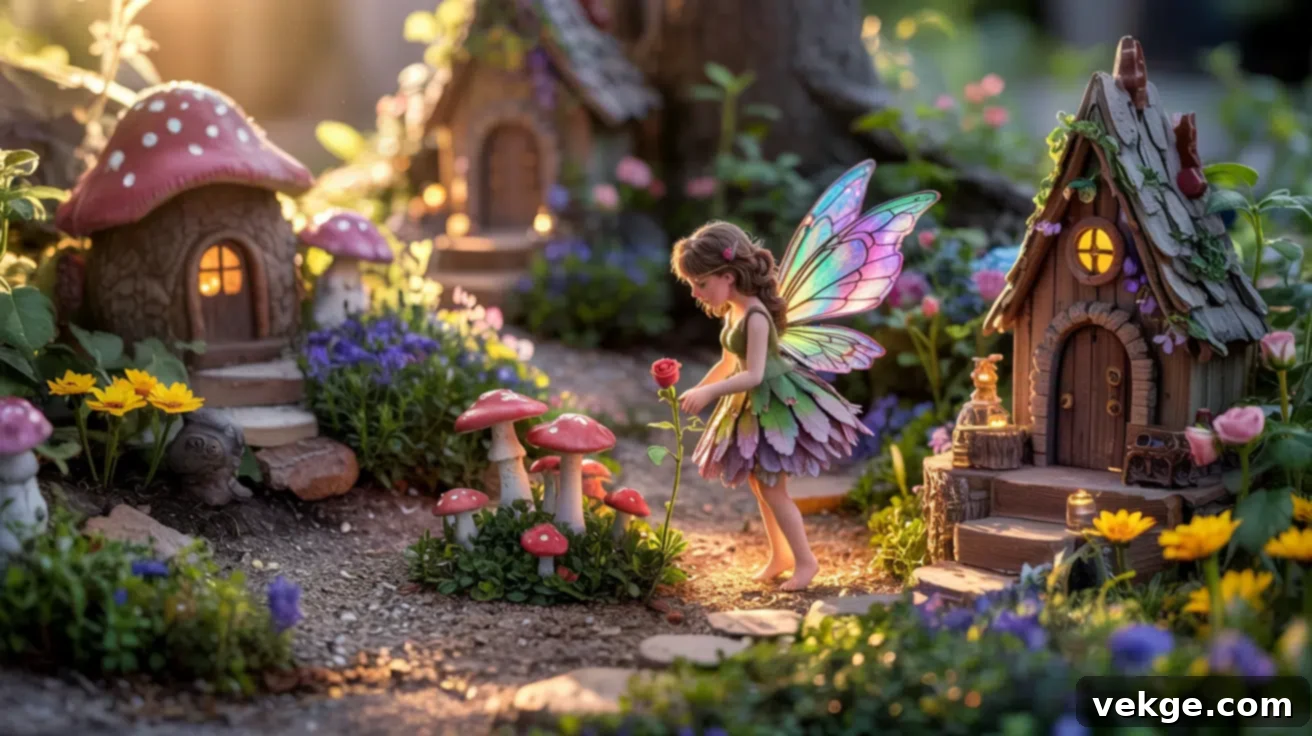Create Your Own Magical Fairy Garden: The Ultimate DIY Guide for Enchanting Spaces
Are you looking to infuse a touch of whimsy and enchantment into your home or outdoor area? Discovering the joy of crafting a fairy garden is an absolutely wonderful way to achieve just that. Many people dream of decorating their space with something truly unique but often feel unsure where to begin or how to make it distinct. This is precisely where fairy gardens shine! They are remarkably easy to start, incredibly fun to build, and bring a sprinkle of magic to any corner they inhabit.
In this comprehensive guide, we’ll walk you through everything you need to know about planning, constructing, and decorating your very own miniature fairy garden. You’ll find simple, actionable steps, inspiring ideas for materials, and abundant creative inspiration for both indoor sanctuaries and outdoor havens. Whether you’re creating a whimsical project for children or a serene escape for adults, these tiny gardens possess a remarkable ability to make a huge impact. Let’s embark on this magical journey!
Start by Defining Your Fairy Garden’s Unique Style
Before you dive into selecting plants and accessories, take a moment to envision the overall atmosphere you want your fairy garden to evoke. This initial step is crucial for creating a cohesive and deeply personal space.
Do you lean towards a rustic, woodland feel, or perhaps something more playful and vibrant? Are you drawn to a natural, earthy aesthetic, or a modern, minimalist design? Consider whether you’d like a seasonal theme, like a cozy winter wonderland, or one inspired by a beloved fairytale. Choosing a style early on will beautifully guide your decisions regarding the layout, color palette, and decorative elements, making the entire creation process more focused and enjoyable. It transforms a simple craft into a personal expression of your imagination.
Once you have a clear vision in mind, explore the diverse range of creative fairy garden setups presented below, designed to suit every kind of space and season.
Essential Tools and Materials You’ll Need
To ensure a smooth and delightful building experience for your fairy garden, gather these fundamental materials beforehand. Having everything ready will allow you to focus purely on the creative process.
- Container or Garden Space: This is your base! Options are endless: a classic flowerpot, a charming wooden box, an elegant glass bowl, an upcycled old drawer, a wheelbarrow, or even a small, defined corner within your existing yard or garden bed.
- Drainage Layer: A layer of small pebbles, gravel, or even broken pot shards is essential. This prevents water from pooling at the bottom of your container, which can lead to root rot and an unhealthy environment for your miniature plants.
- Potting Soil: Opt for high-quality, well-draining potting soil suitable for container gardening. If you plan to feature succulents or cacti, a specialized cactus and succulent mix will provide the optimal growing conditions.
- Plants: Choose miniature plants that fit the scale of your garden. Excellent choices include various types of moss (sheet moss, cushion moss), small succulents (sedums, echeverias), tiny flowering plants (like miniature violets or primroses), or even fragrant herbs such as mint, thyme, or oregano for a sensory experience.
- Accessories: These bring your fairy garden to life! Think charming fairy figurines, quaint tiny doors, miniature benches, whimsical animal figures, glowing stones that charge in the light, or delicate battery-operated string lights for evening sparkle.
- Decor Pieces (Optional but Recommended): Personalize your garden with natural elements like small twigs, pieces of bark, smooth river stones, polished glass beads, or custom-made mini signs. Anything that sparks your imagination and fits the scale can be included!
Crafting Your Fairy Garden: A Simple Step-By-Step Guide
Building a magical fairy garden is an incredibly rewarding and straightforward process when approached with clear steps. Here’s how you can transform a simple container into your very own enchanted mini-world from the ground up.
Step 1: Select Your Perfect Container

The foundation of your fairy garden begins with selecting the right base. Consider your available space and desired aesthetic. Will it be a grand flowerpot, a rustic wooden box, a clear glass bowl, or an unexpectedly charming old drawer? Ensure your chosen container offers enough depth and surface area to comfortably accommodate your plants and decorations. For outdoor fairy gardens, durability is key, so opt for weather-resistant materials. For indoor setups, a shallow tray or a wide-mouthed terrarium can work beautifully, allowing for easy viewing.
Step 2: Establish Drainage and Add Soil
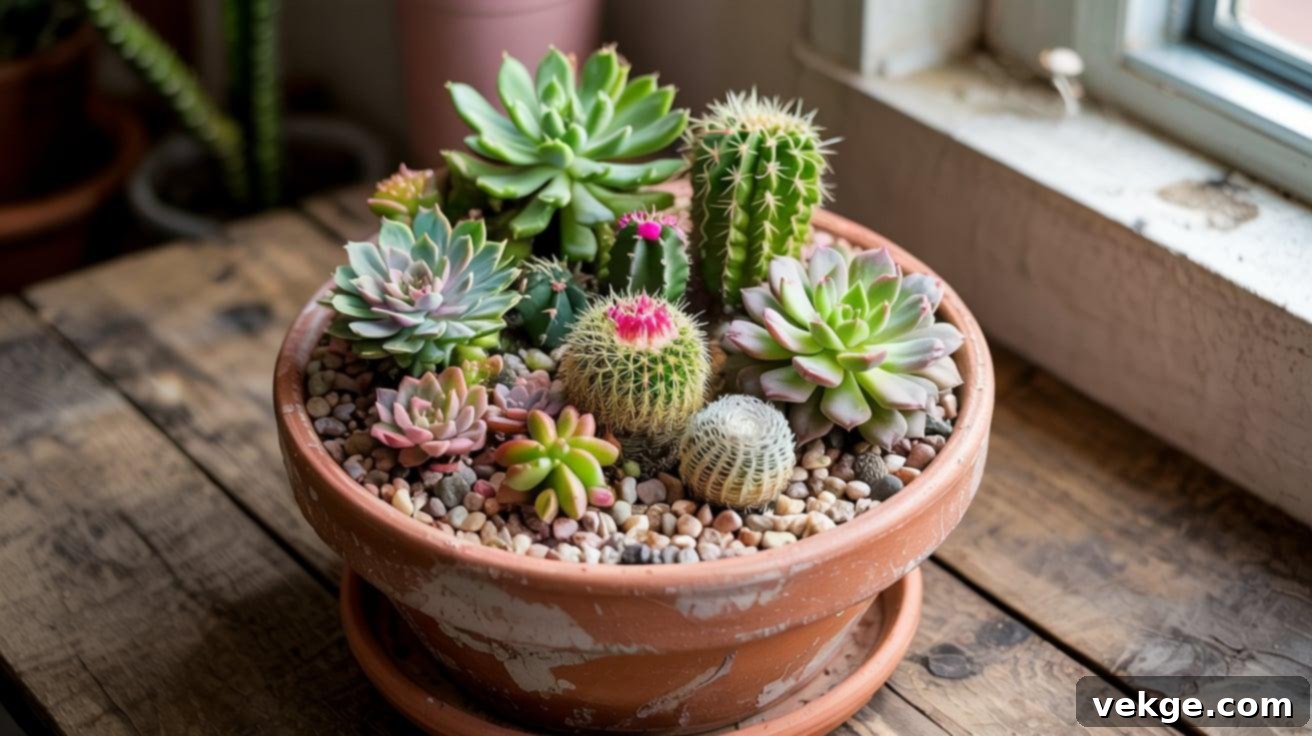
Proper drainage is vital for the health of your miniature plants. Begin by layering the bottom of your container with about one to two inches of small pebbles, gravel, or broken pottery pieces. This creates a crucial reservoir for excess water. Following this, fill the container with your chosen well-draining potting soil. As mentioned, a specialized cactus mix is ideal if your garden will predominantly feature succulents, ensuring they receive the proper aeration and moisture levels.
Step 3: Strategically Plan Your Layout

Before you permanently place any elements, take a moment to visualize your miniature landscape. This planning phase is incredibly fun and helps prevent later adjustments. You might sketch a simple diagram on paper, or even better, loosely arrange your plants and decorations in the container without planting them. This allows you to experiment with different compositions, leaving designated spaces for paths, key features, and, of course, your vibrant miniature plants. Think about creating different “zones” or levels within your garden.
Step 4: Introduce Your Miniature Plants
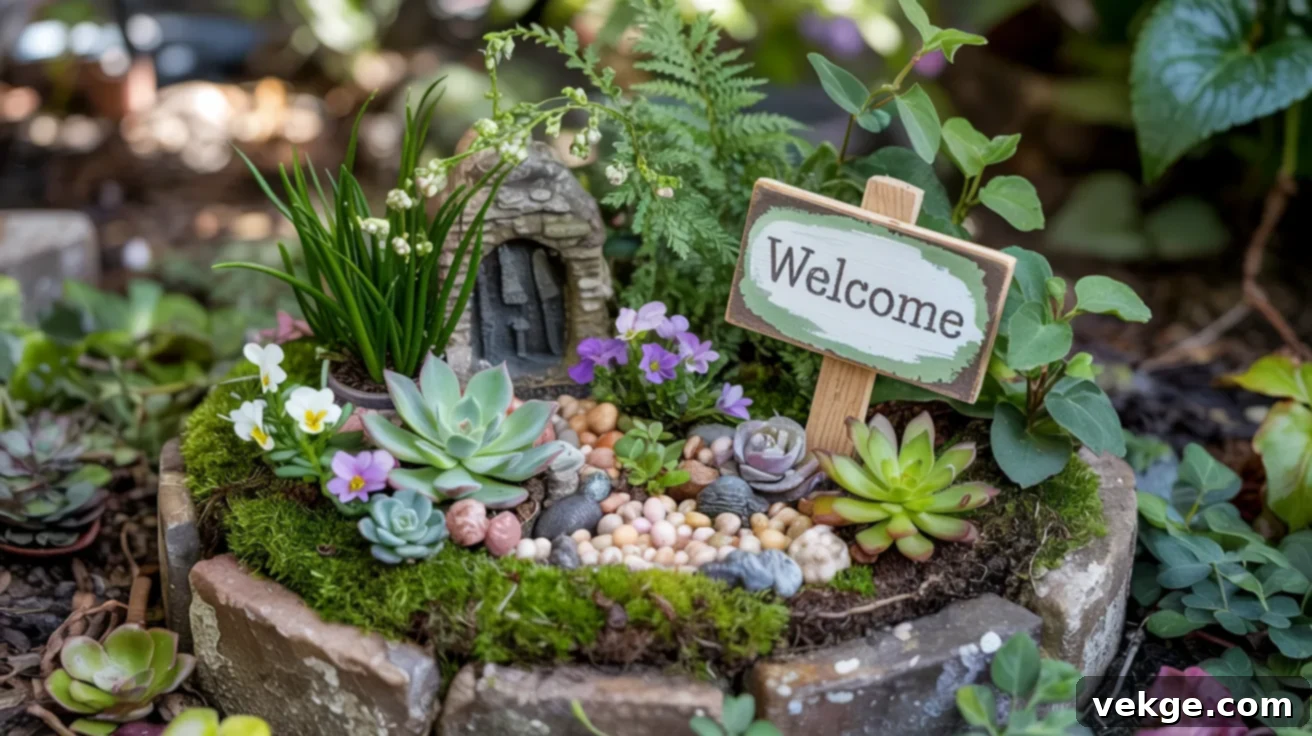
Now for the greenery! Start by carefully planting your chosen miniature plants. Place taller plants, like small ferns or miniature trees, towards the back of your garden to create a backdrop and a sense of depth. Shorter plants, ground covers like moss, or trailing succulents can be positioned in the foreground and along the edges. It’s essential to select plants that thrive in similar light and watering conditions to ensure a healthy and harmonious ecosystem for your tiny world.
Step 5: Construct Paths and Landscape Features
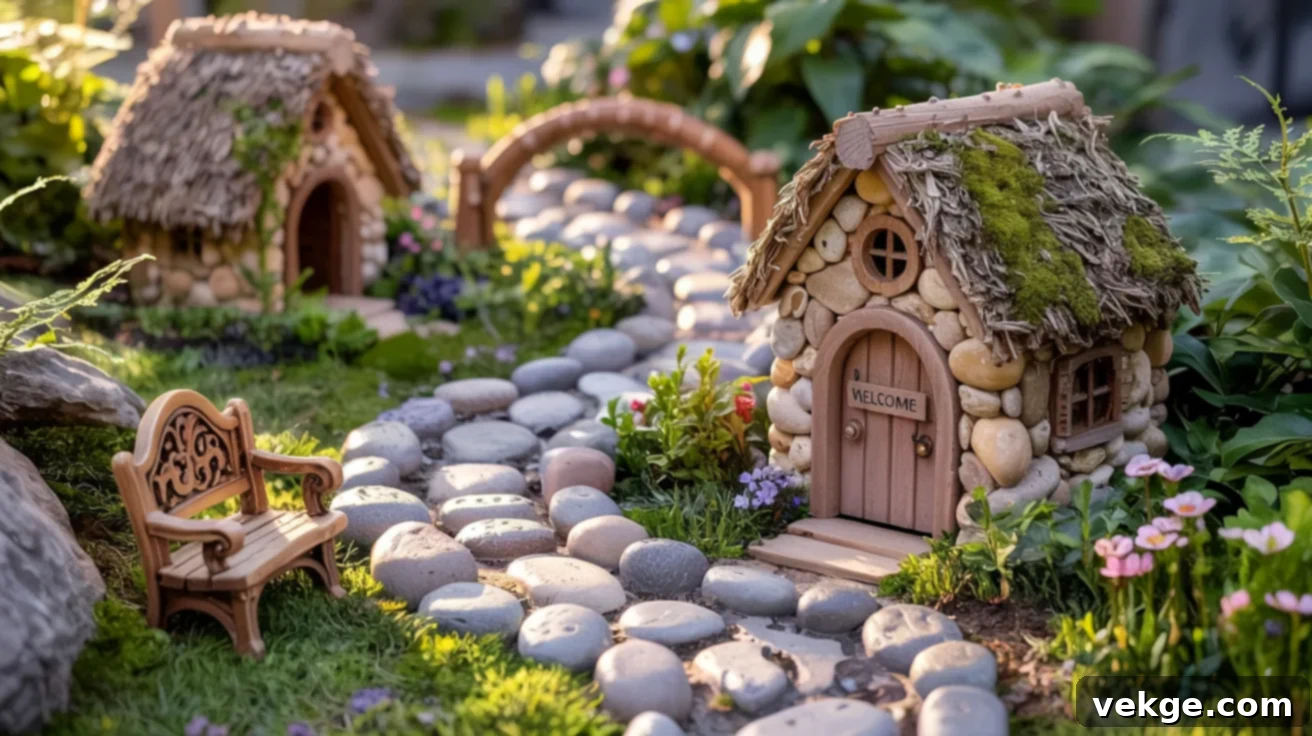
Add structure and intrigue to your fairy garden by creating winding paths and distinctive landscape features. Use small pebbles, fine gravel, flat pieces of bark, or even miniature wooden popsicle sticks to define whimsical pathways. Incorporate charming elements like tiny fairy doors nestled against a plant, mini fences crafted from twigs, or small stairs made from stacked bark or flat stones. Arrange these elements organically, imagining where a real fairy might roam or reside, making the scene feel truly lived-in.
Step 6: Thoughtfully Place Decorations

This is where your fairy garden truly comes alive! Carefully position your small fairy figurines, tiny benches, miniature signs, and various animal figures to tell a story. For an extra touch of enchantment, especially at night, sprinkle glow-in-the-dark stones along paths or tuck in small, battery-operated LED string lights. Don’t hesitate to mix store-bought accessories with unique homemade items—this blend adds a wonderful personal touch and makes your garden truly one-of-a-kind.
Step 7: Apply the Final Charming Touches
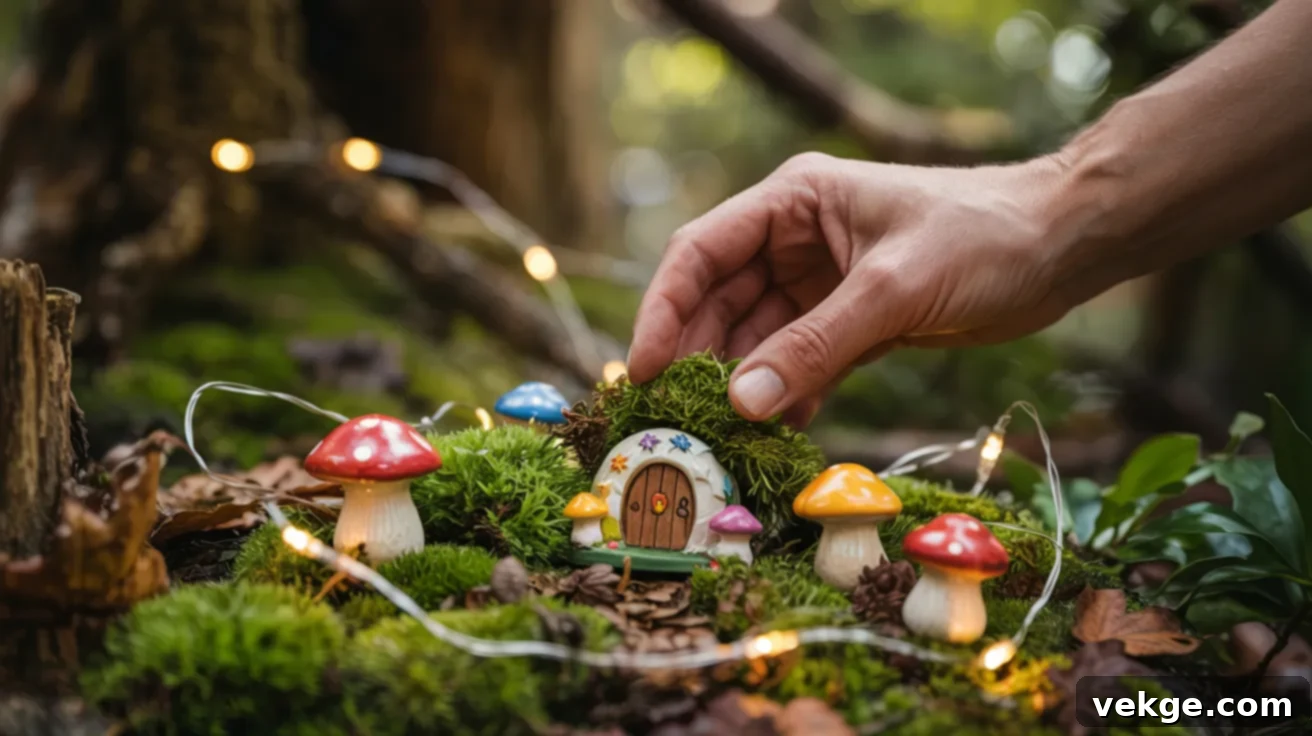
With all the main elements in place, it’s time for the finishing details. Gently tuck in any remaining moss or filler materials to cover exposed soil patches and create a natural, lush look. Step back and assess your creation from different angles, ensuring every piece feels balanced, aesthetically pleasing, and cozy. Once you’re completely satisfied with your magical arrangement, give your newly completed fairy garden a light, gentle watering to settle the soil and help your plants adjust to their new home.
Inspiring and Unique Fairy Garden Ideas for Every Imagination
Beyond the basics, the true magic of fairy gardens lies in their boundless potential for unique themes. Here are some distinctive fairy garden ideas to spark your creativity, transforming your space into an extraordinary miniature realm:
1. Beach-Themed Fairy Garden: A Coastal Retreat
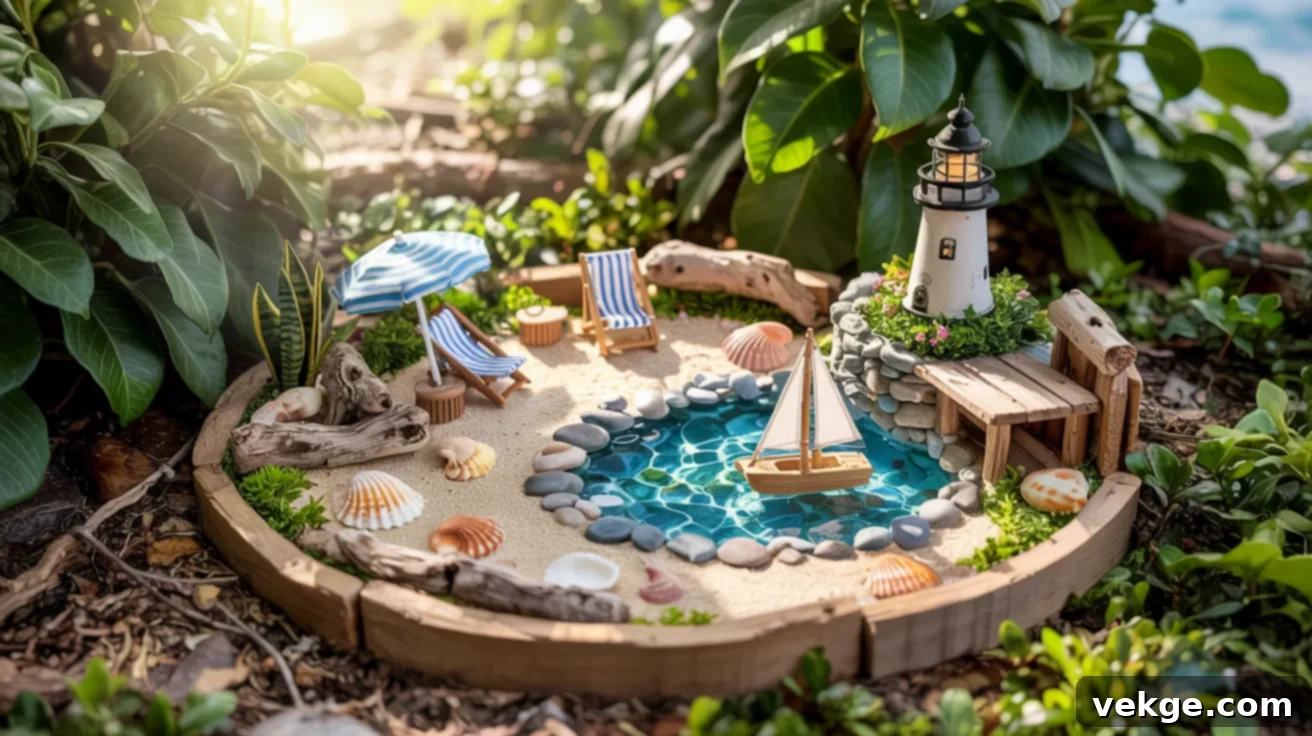
Evoke the calming essence of the seaside with a beach-themed fairy garden. Use fine white sand as your base, adorned with an assortment of miniature seashells and weathered driftwood pieces. Add charming accessories like a tiny beach chair, a mini umbrella, or even a diminutive surfboard. A shallow bowl or tray makes an ideal container for this theme. Incorporate blue-colored stones or glass beads to simulate a sparkling water area. This concept thrives indoors in sunny spots and is perfect for kids to add plastic fish or tiny sea creatures. A miniature lighthouse or a small boat can provide additional delightful details, bringing the tranquility of the shore to your home.
2. Woodland Fairy Garden: Deep Forest Enchantment
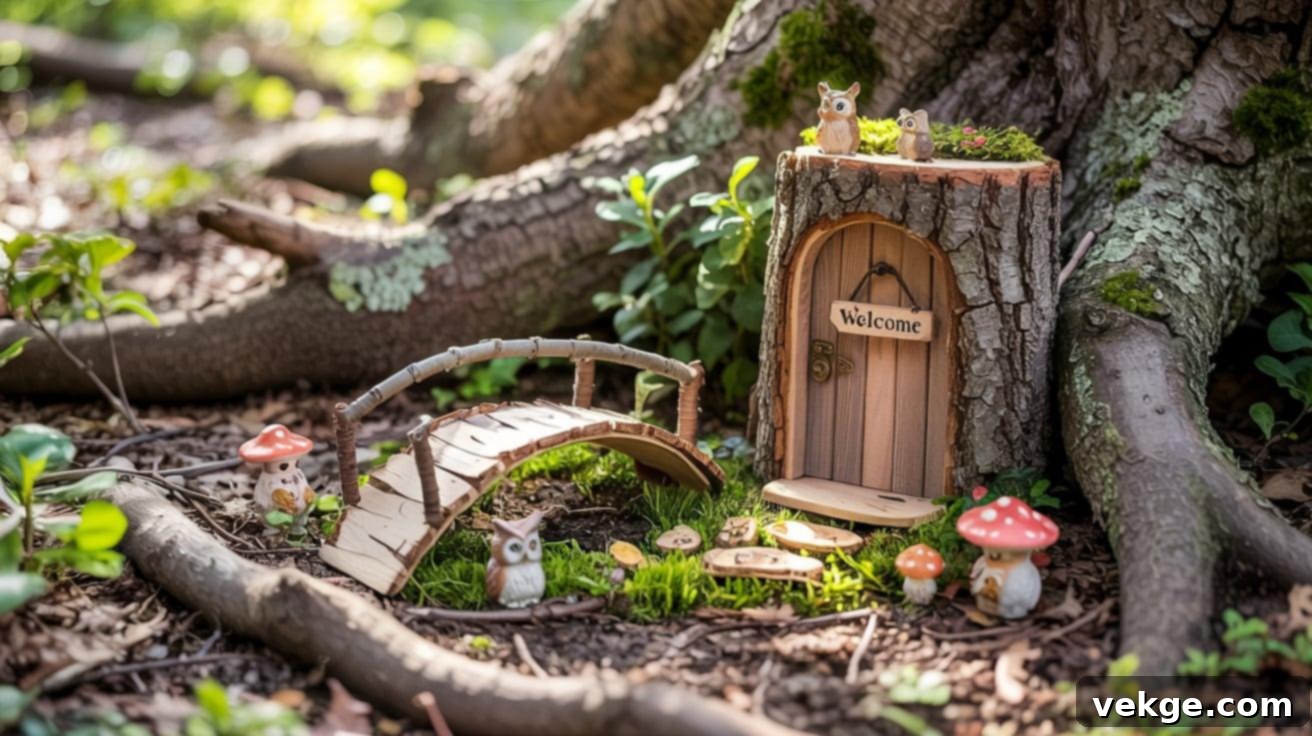
For a truly natural feel, create a woodland fairy garden. This style thrives outdoors in a shady spot, perhaps under a large tree or nestled amongst existing foliage. Utilize abundant moss, small twigs, and various pieces of bark to mimic a forest floor. Populate your miniature forest with tiny animal figures like deer, squirrels, or owls. Adorable little mushrooms, both real and artificial, will enhance the forest illusion. An old, hollowed-out log can serve as a fantastic natural container, and a small wooden door or bridge will make it seem as though magical creatures truly reside within. This is an excellent choice for outdoor backyards.
3. Miniature Village Fairy Garden: A Bustling Borough

Dream bigger and construct an entire miniature village! Design a landscape featuring several tiny homes, intricate paths, and quaint mini fences. Each section can represent a distinct “neighborhood” for your fairy inhabitants. Illuminate your village with delicate fairy lights or strategically placed glow rocks, bringing it to life after dusk. A large planter, a wide shallow tub, or even a repurposed wagon works well for this expansive theme. It’s perfect for indoor corners, covered porches, or a spacious patio. Changing decorations seasonally can add continuous interest and charm.
4. Fairy Garden in a Teacup: Charming and Compact
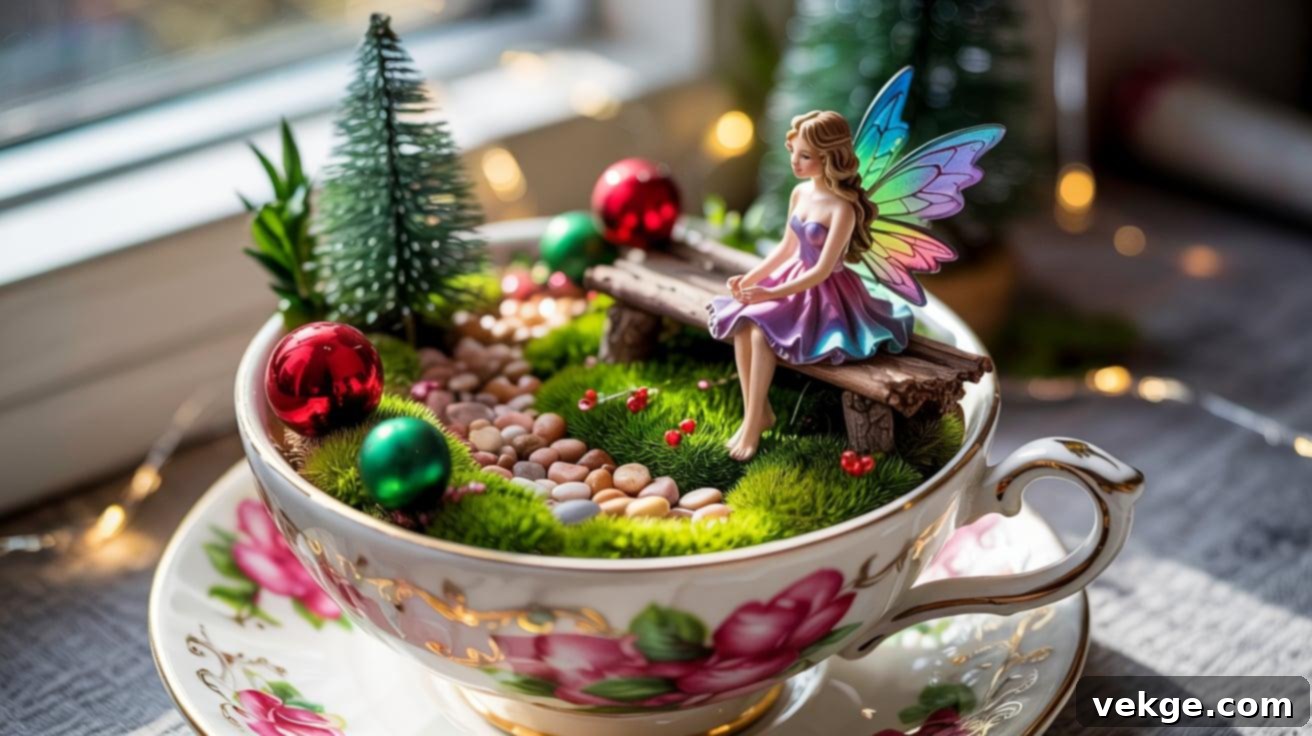
For a delightfully small and portable fairy garden, choose an oversized teacup or a decorative mug. Fill it with a base layer of tiny pebbles, followed by a small amount of soil and lush moss. Add a single, tiny fairy figurine and use minuscule twigs, buttons, or beads for decoration. These teacup gardens are perfect for desks, bookshelves, or narrow window ledges. They are incredibly easy to move and maintain, making them lovely gifts. You can even theme them for holidays, using festive colors for Christmas or romantic motifs for Valentine’s Day.
5. Succulent Fairy Garden: Drought-Tolerant Beauty
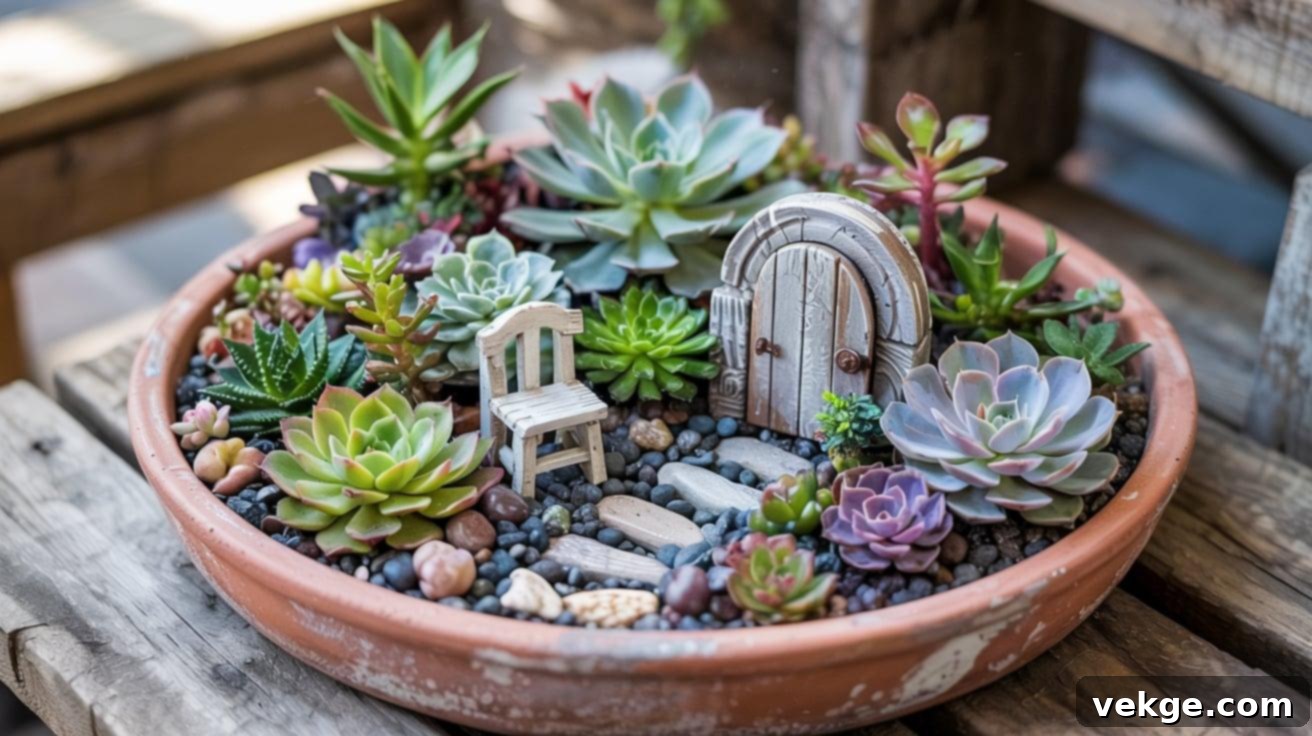
Succulents are a fantastic choice for fairy gardens due to their low maintenance needs and captivating variety of shapes and colors. Use a shallow dish or a wide, decorative pot. A base of sand or gravel with a succulent-specific soil mix will ensure their health. Include a tiny fairy chair, a miniature door, or small decorative stones to complement the plants. A mix of green, purple, and blue succulents creates a stunning visual display. These gardens are incredibly durable and visually appealing, suitable for both indoor and outdoor settings, making them an excellent option for beginners or those who sometimes forget to water their plants.
6. Terrarium Fairy Garden: A Self-Contained World
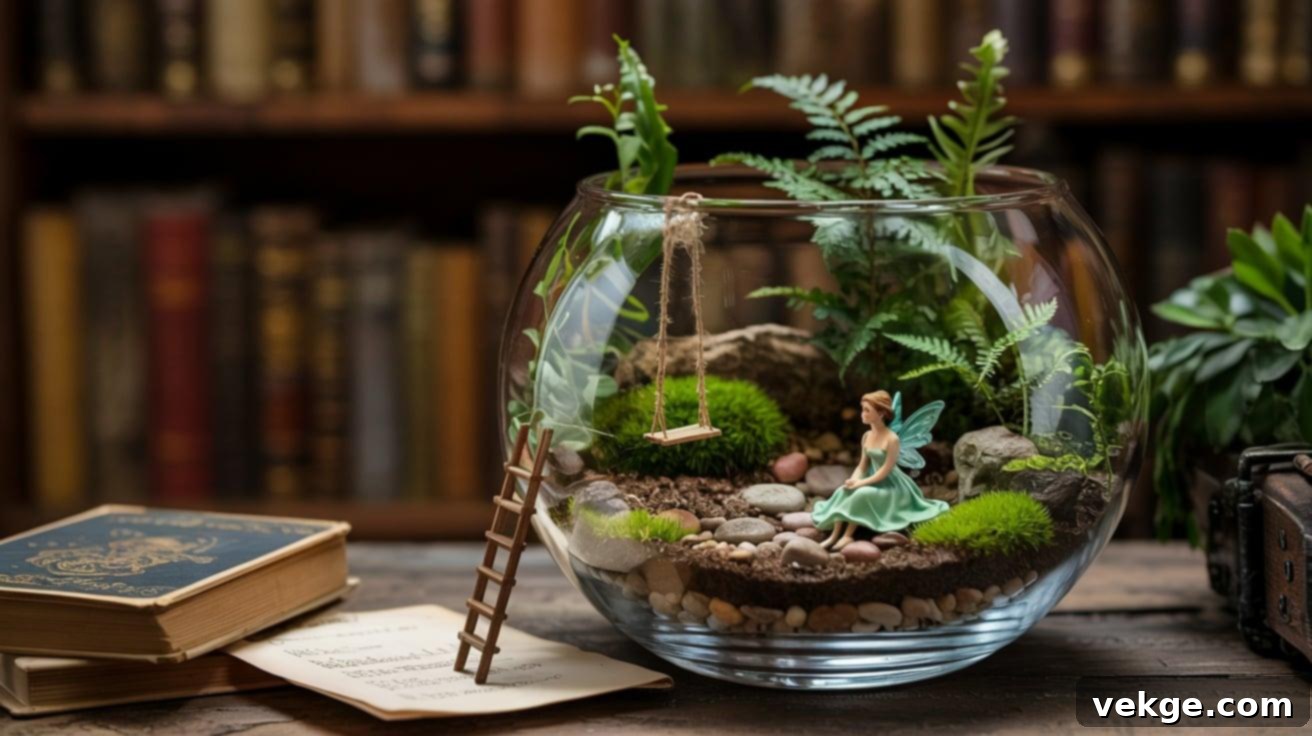
Create a captivating, self-contained ecosystem within a glass jar or bowl. Build layers starting with drainage stones, followed by a thin layer of activated charcoal (for freshness), soil, and then lush moss and tiny, humidity-loving plants. Introduce a small fairy or animal figure to inhabit this miniature world. Terrarium fairy gardens look magnificent on bookshelves, coffee tables, or as centerpieces. Choose low-light plants like small ferns, baby’s tears, or miniature ivies. Add small decorative pebbles, a tiny swing, or a ladder to enhance the enclosed magic. Remember to keep the glass clean for optimal viewing.
7. Fairy Garden in a Broken Pot: Ingenious Upcycling
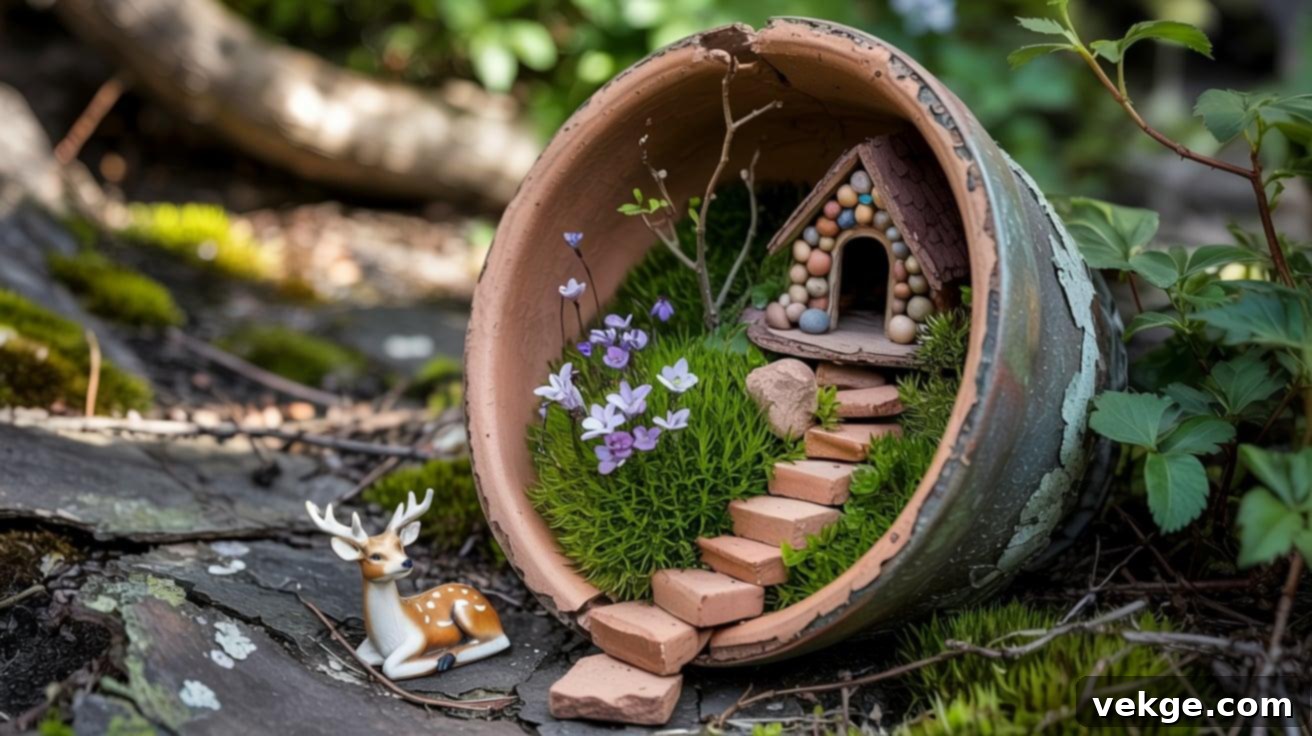
Don’t discard a cracked or broken terracotta pot; instead, transform it into a unique multi-level fairy garden! Lay the main pot sideways or upright, using the broken shards to construct enchanting miniature stairs, walls, or different tiers within the pot. Fill these sections with soil, vibrant moss, and a variety of tiny plants. Add a charming fairy house at the highest point to complete the scene. This style evokes the image of a secret fairy dwelling carved into a mountainside, making it a perfect conversation piece for porches or patios. Each broken pot garden is inherently unique, adding to its special charm.
8. Winter Wonderland Fairy Garden: Frosty Magic

Embrace the beauty of the colder months with a winter wonderland theme. Use artificial snow or soft cotton batting to simulate snowdrifts, complemented by white stones and delicate pine branches. Incorporate miniature sleds, tiny snowmen figures, or a cozy fairy bundled in a scarf. White LED lights will provide a soft, enchanting glow reminiscent of winter nights. This garden works best in a shallow tray or pot and is ideal for indoor display during December, adding festive cheer. Consider adding a small reindeer or penguin figure for extra holiday delight.
9. Halloween-Themed Fairy Garden: Spooky & Sweet

Celebrate the spooky season with a whimsical Halloween fairy garden. Use dark potting soil, orange pebbles, and eerie yet charming fairy homes. Adorn your garden with miniature pumpkins, bats, tiny ghosts, or a black cat figurine. A mini witch’s hat or a tiny cauldron adds an extra touch of seasonal fun. Display it on a porch, windowsill, or mantelpiece throughout October to embrace the holiday spirit. Glow-in-the-dark paint on elements or small orange and purple mini lights can make it truly shine at night.
10. Fairy Garden in a Lantern: Portable Charm
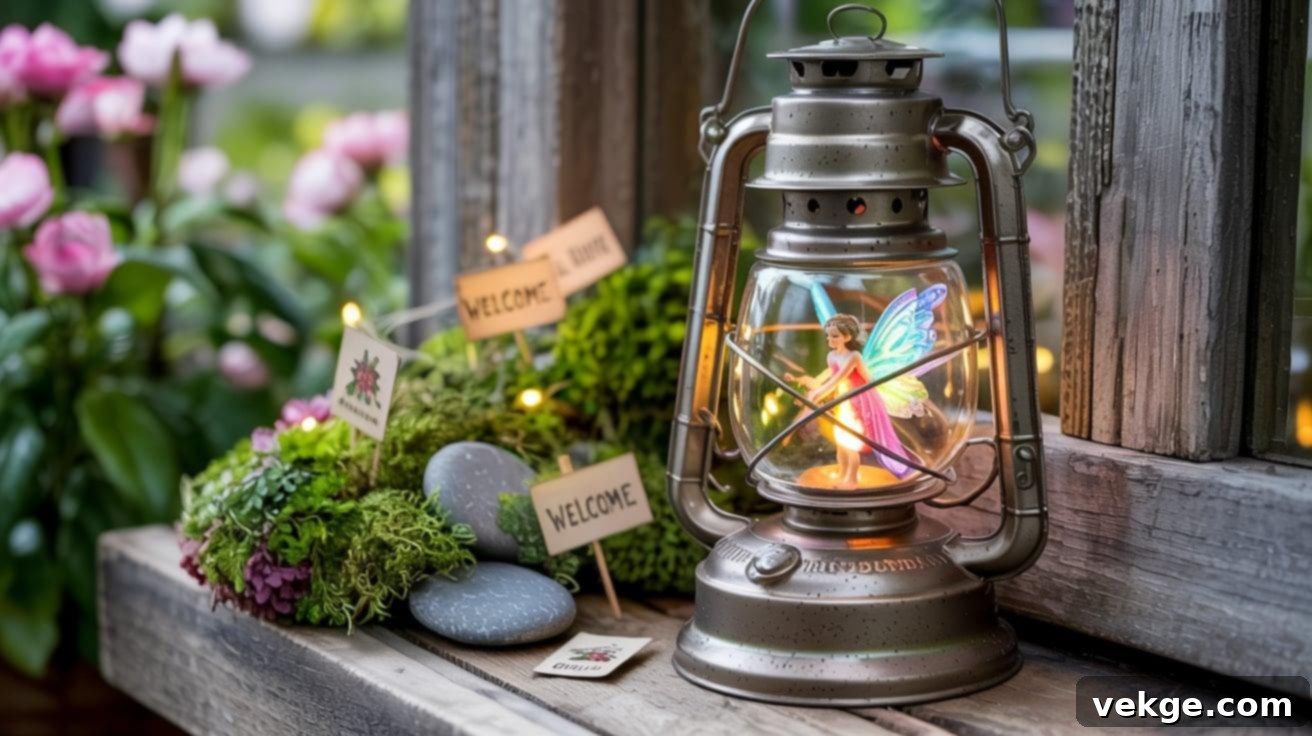
Repurpose an old decorative lantern by removing the glass panels and creating a fairy garden inside. Fill the bottom with a layer of moss, tiny stones, and a small, delicate fairy figure. Lantern fairy gardens are perfect for both indoor display and covered patios. They are lightweight and easily moved, and can even be hung to create a floating magical scene. Add tiny signs, paper flags, or dried flowers for a charming, low-maintenance display. This is a brilliant idea for those with limited space, offering seasonal versatility.
11. Fairy Garden for Kids: Imagination Unleashed

Engage young imaginations with a child-friendly fairy garden. Use larger, more durable plastic figures and sturdy pots. Encourage kids to choose their favorite themes, whether it’s dinosaurs, robots, or farm animals coexisting with fairies. Incorporate bright colors and playful, oversized decorations. A simple, robust fairy house and small, child-safe toys can be included. Allow them to participate in watering and rearranging elements, transforming it into their very own evolving miniature world. Prioritize non-breakable materials for safety and longevity.
12. Zen Fairy Garden: A Miniature Sanctuary
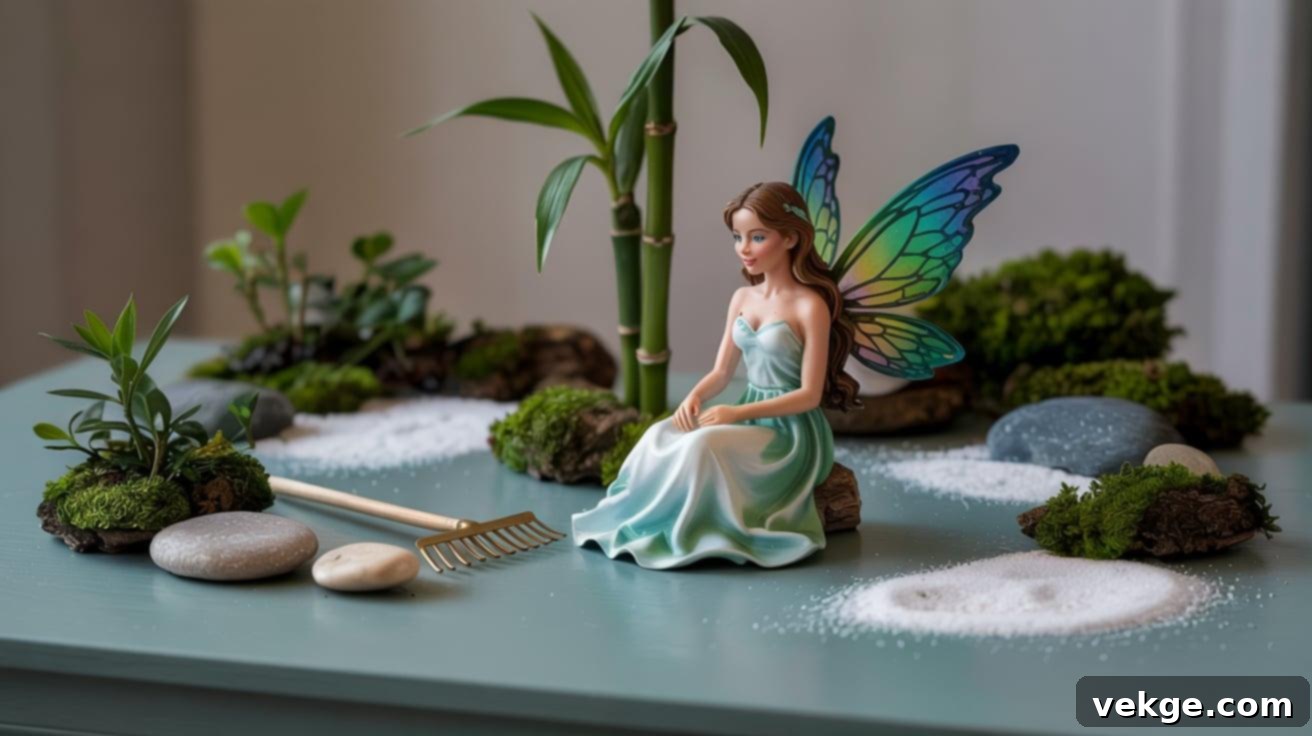
Cultivate tranquility with a Zen-themed fairy garden, designed for calm and contemplation. Utilize fine white sand, carefully placed smooth stones, and soft, lush moss. Add miniature elements like a tiny rake to create patterns in the sand, polished river rocks, and a small fairy figure in a peaceful, meditative pose. You could also include a mini bamboo piece or a tiny, reflective pond. This type of garden is ideal for desks or quiet corners, promoting a sense of relaxation and mindfulness. It’s easy to create and maintain, offering a serene visual escape.
13. Fairy Garden in a Birdcage: Elevated Elegance
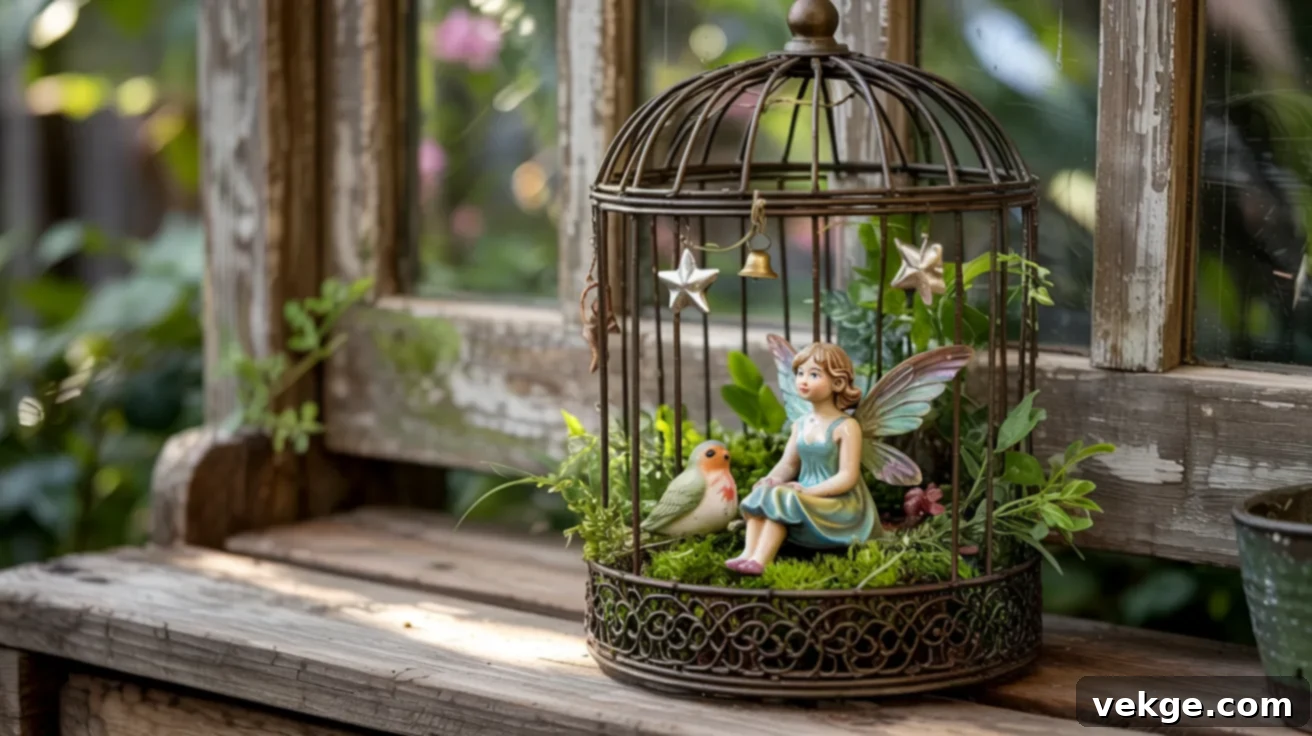
Give an old birdcage a new lease on life by transforming it into an elegant fairy garden. Source a vintage birdcage from a thrift store or antique shop. Line the bottom with moss and arrange miniature plants and soil. Hang delicate decorative pieces like tiny stars, bells, or crystal drops from the cage bars. Place a fairy or miniature bird figure inside to complete the scene. These hanging gardens are perfect for indoor display or covered porches, adding a touch of sophisticated whimsy. Consider using dried or artificial flowers for a no-maintenance option.
14. Tree Stump Fairy Garden: Naturally Integrated
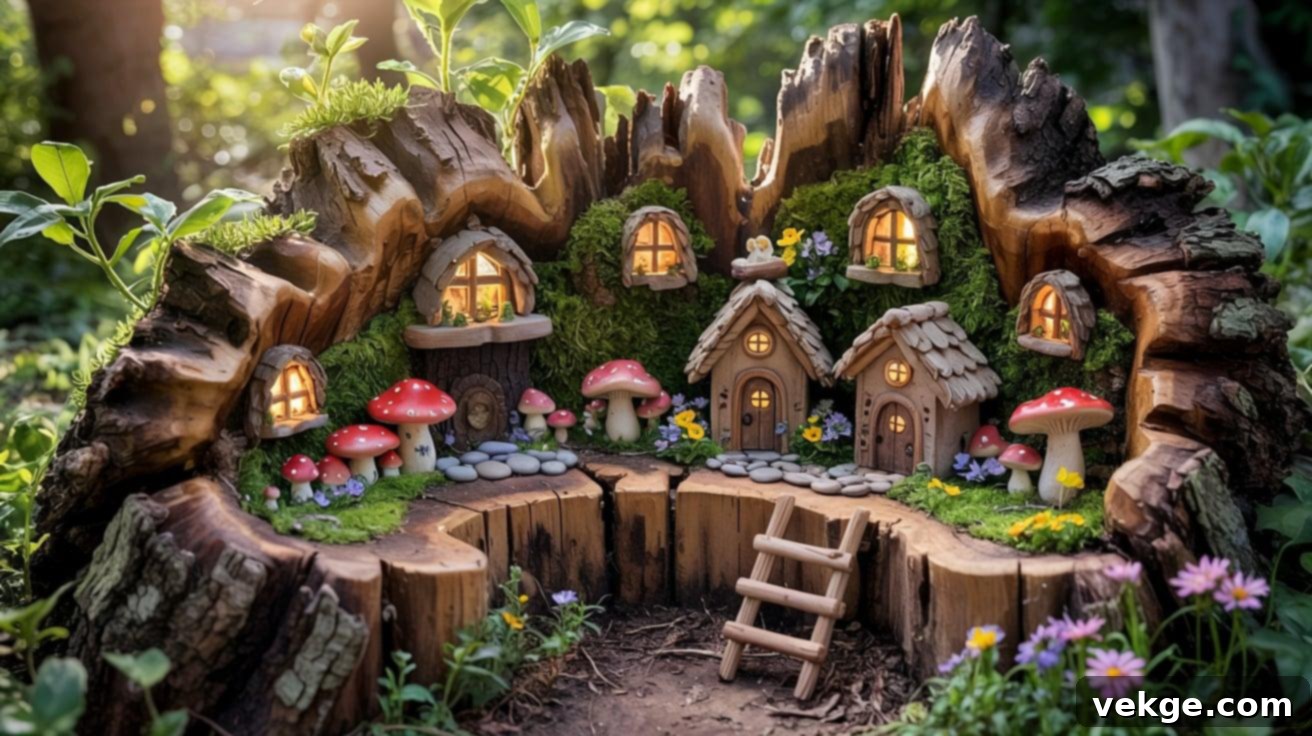
Utilize a hollow tree stump or a sturdy old log in your garden to create a truly integrated fairy habitat. Fill the hollow with soil and a vibrant array of moss and tiny plants. Incorporate miniature ladders leading up the stump, small windows carved into the bark, and charming fairy houses nestled within. This design makes it appear as though fairies have made their home directly within the natural landscape. You can also plant a ring of small flowers around the base to further blend it into your garden. Children particularly love discovering tiny fairies hidden in unexpected nooks within the stump.
15. Fairy Garden with a Water Feature: Soothing Sounds
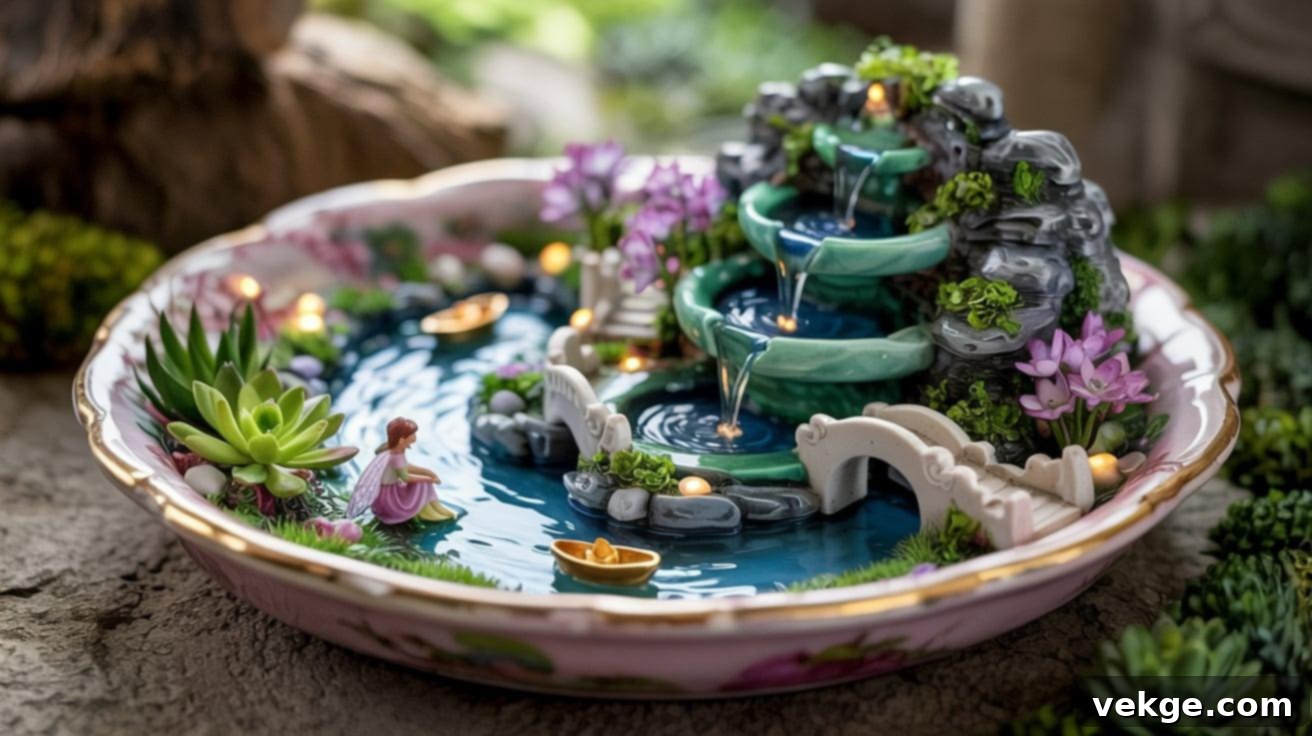
Introduce the calming element of water with a miniature fountain or a small, self-contained dish of water. Add tiny bridges spanning the “water,” small water plants (if the scale allows), and miniature fairy boats. A small, submersible pump can create a gentle, moving water effect, enhancing the sensory experience. Include waterproof fairy figures or miniature fish. This type of garden is best suited for outdoor settings, allowing the soothing sounds of water to complement the visual charm. Small, strategically placed lights around the water feature will create a mesmerizing effect at night.
16. Herb Fairy Garden: Fragrant and Functional

Combine beauty with utility by creating an herb fairy garden. Plant miniature varieties of mint, thyme, parsley, or other small herbs, adding delightful fairy touches. Use small individual pots or a dedicated planter box as your base. Incorporate a tiny fairy door, a friendly gnome figure, or a miniature table and chairs among the herbs. You can enjoy both the visual appeal of the fairy theme and the practical benefit of fresh herbs for cooking. These gardens thrive on kitchen windowsills or patios and offer a pleasant aroma. It’s an excellent project for beginners and culinary enthusiasts alike.
17. Indoor Shelf Fairy Garden: Multi-Level Magic
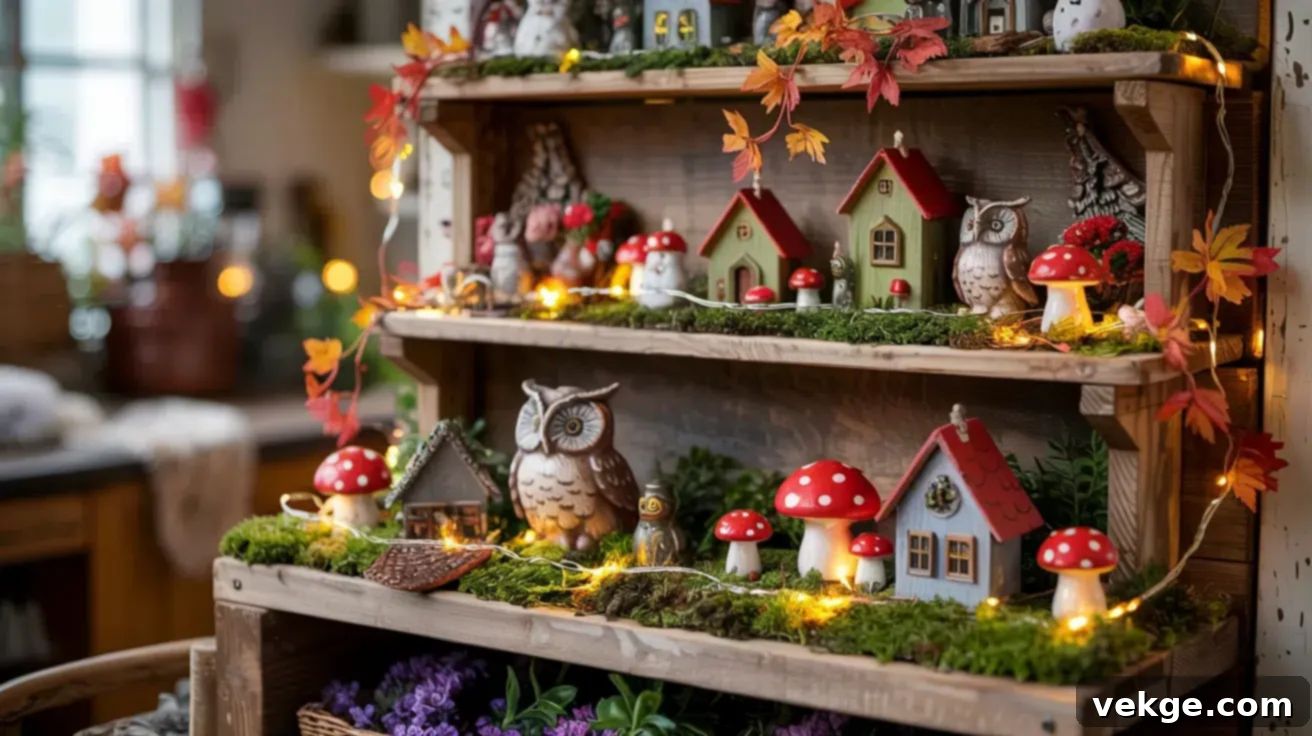
Transform a section of a bookshelf or a side table into a captivating indoor fairy garden. Place a decorative tray or a woven basket filled with soft moss, smooth stones, and a collection of miniature homes. Arrange figures such as fairies, tiny owls, or charming mushrooms across the landscape. The beauty of a shelf garden is its adaptability; you can easily change the setup with the seasons. Utilize different levels on your shelf to create a multi-tiered magical world. It’s a clean and playful way to bring enchantment indoors without needing outdoor space.
18. Windowsill Fairy Garden: Sunlight and Charm
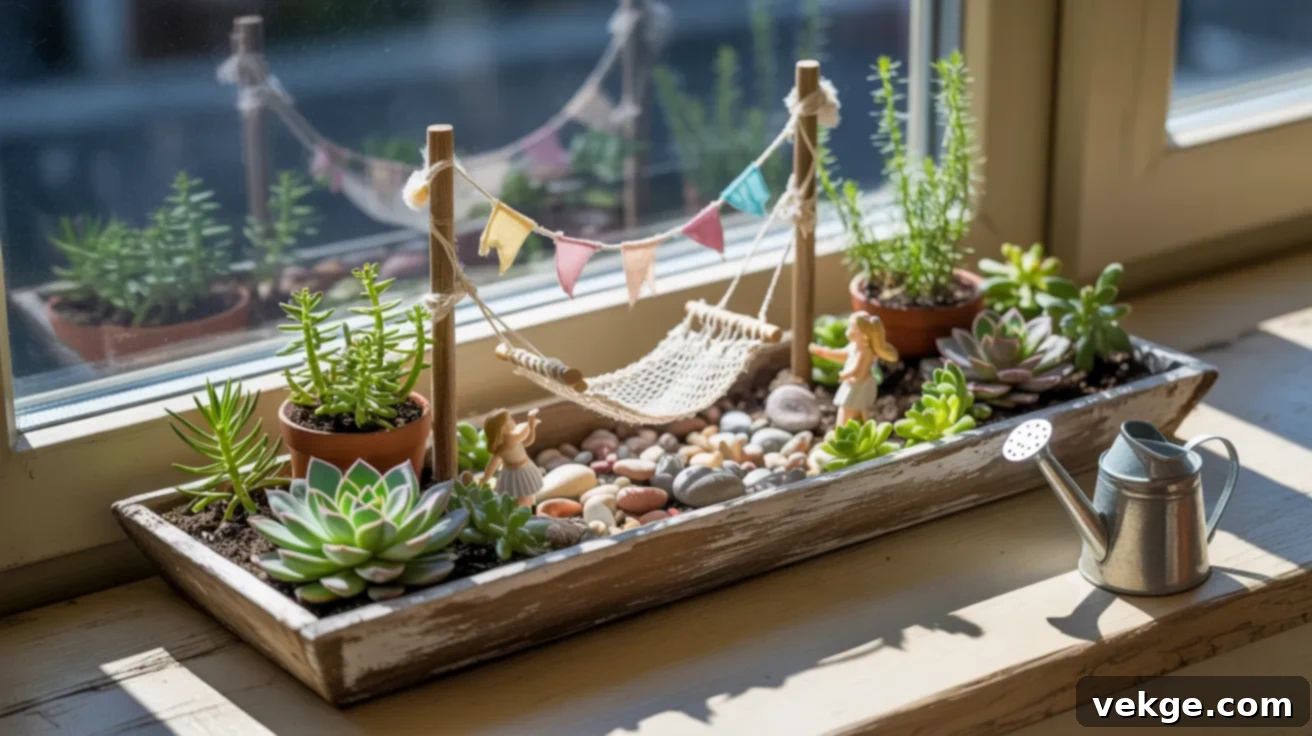
Maximize natural light by creating a fairy garden on your windowsill. Select a long, narrow tray or a series of small, connected pots. Plant small, sun-loving potted plants, incorporate various fairy accessories, and scatter fun, colorful stones. The direct sunlight will help your simple plants flourish. This is a perfect solution for apartments or homes without a yard. Add small flags, a tiny fairy hammock, or a miniature clothesline for extra charm. These gardens are easy to maintain and provide a delightful view every morning, ideal for small spaces.
19. Fairy Garden with Glow-in-the-Dark Elements: Nighttime Wonder
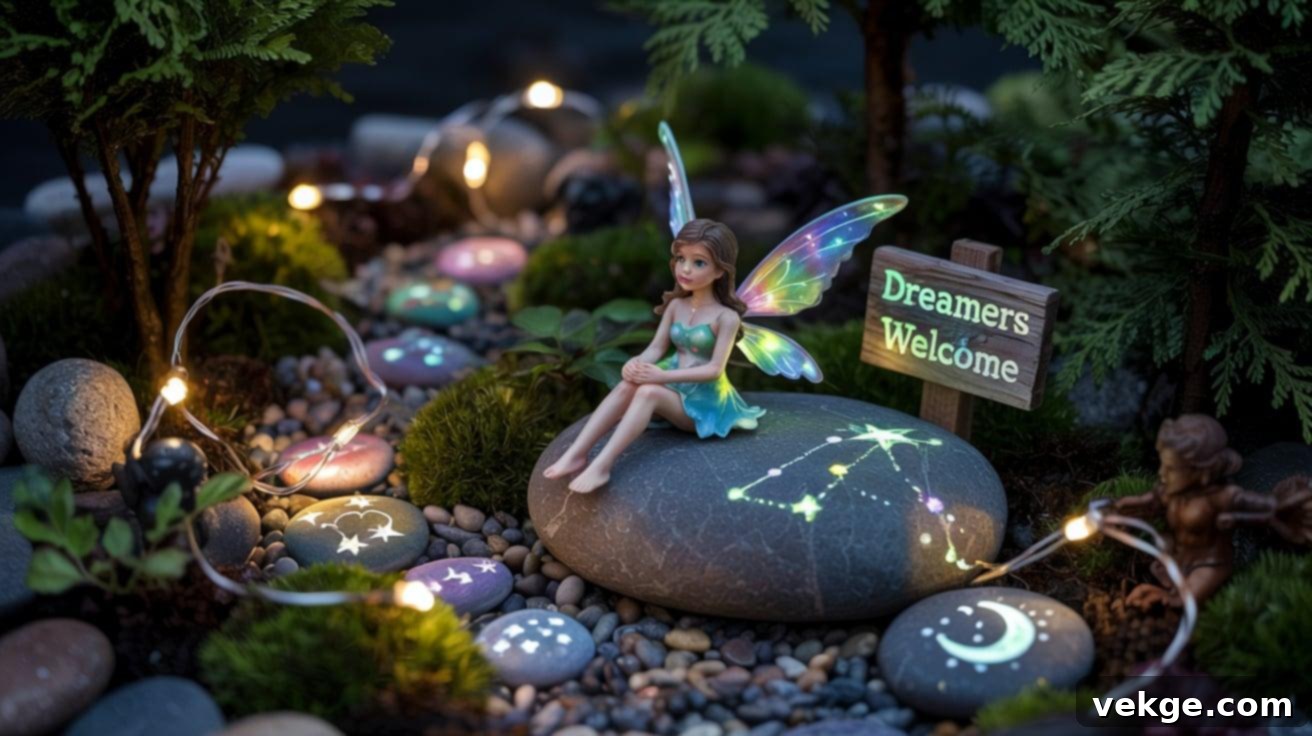
Add an ethereal glow to your fairy garden with glow-in-the-dark elements. Apply glow paint to small stones, stars, or tiny signs, and integrate them into your garden, particularly effective against darker soil or backdrops. These elements absorb light during the day and emit a soft, magical luminescence at night. Supplement with small, battery-operated lights for additional sparkle. This theme works beautifully in bedrooms, on patios, or in any area where it can be appreciated after dark. Kids especially love helping to paint these glowing pieces.
20. Storybook-Themed Fairy Garden: Narratives in Miniature
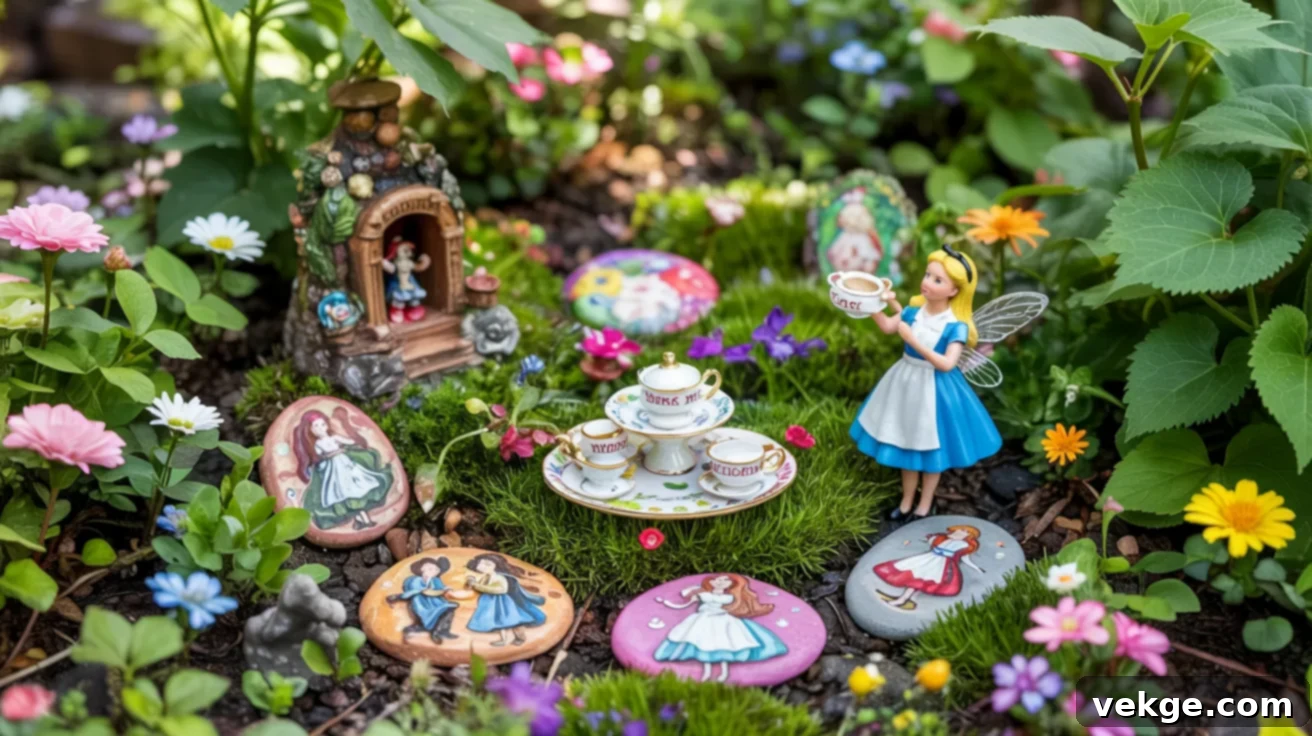
Bring your favorite tales to life with a storybook-themed fairy garden. Choose a beloved story, such as “Alice in Wonderland,” “Peter Pan,” or a classic fairytale. Recreate miniature scenes from the book using specific characters, iconic props, and imaginative signs. This is a truly delightful theme for book lovers and can be set up indoors or outdoors. For an extra personal touch, paint pebbles with famous quotes or key scenes from the chosen story, turning your garden into a miniature narrative.
21. Desert Fairy Garden: Arid and Alluring
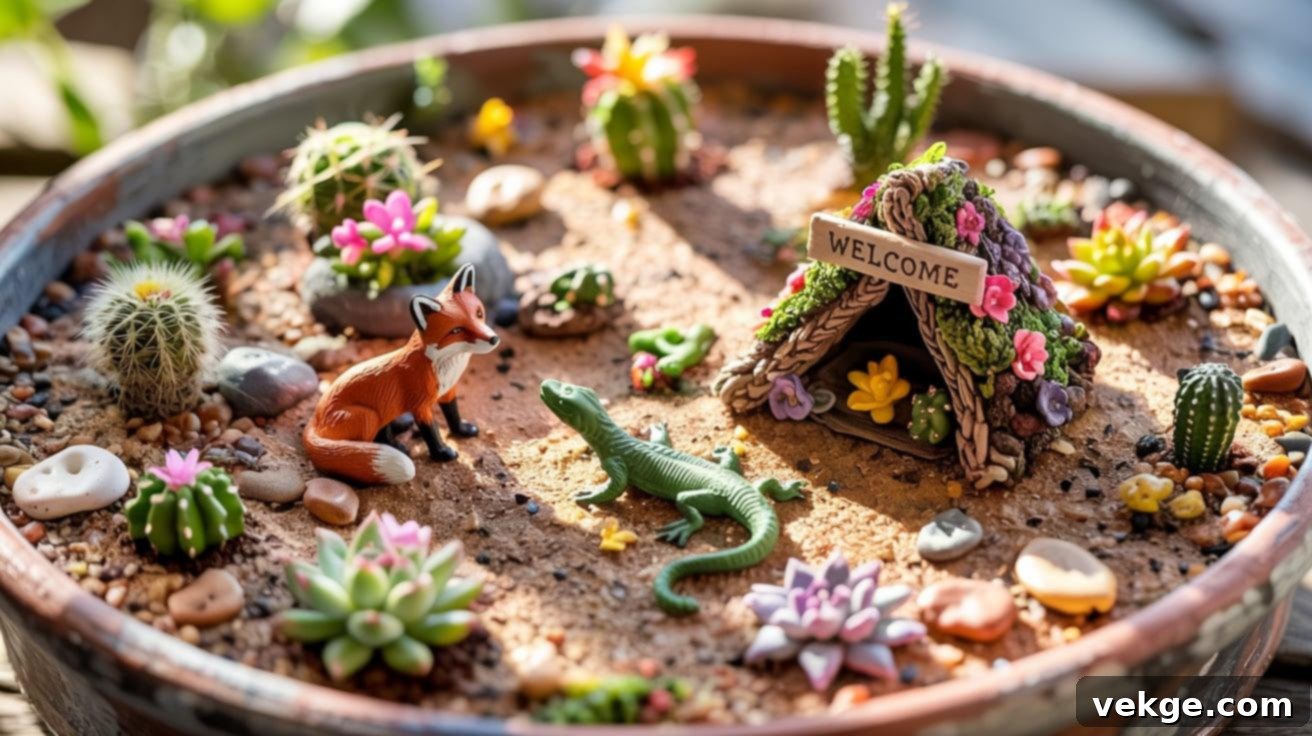
Embrace the rugged beauty of the desert with a uniquely themed fairy garden. Use sand and gravel as the dominant ground cover, and populate it with various resilient cactus plants and hardy succulents. Incorporate a tiny fairy tent, a miniature wagon, or even a small oasis feature. A wide, shallow pot is ideal for this design. Select figures representing desert animals like lizards, foxes, or even tiny snakes for a touch of authenticity. This garden is perfect for dry climates and hot weather, requiring very little water. Use clay or stone fairy homes to blend seamlessly with the desert aesthetic.
22. Tropical Fairy Garden: Lush and Exotic
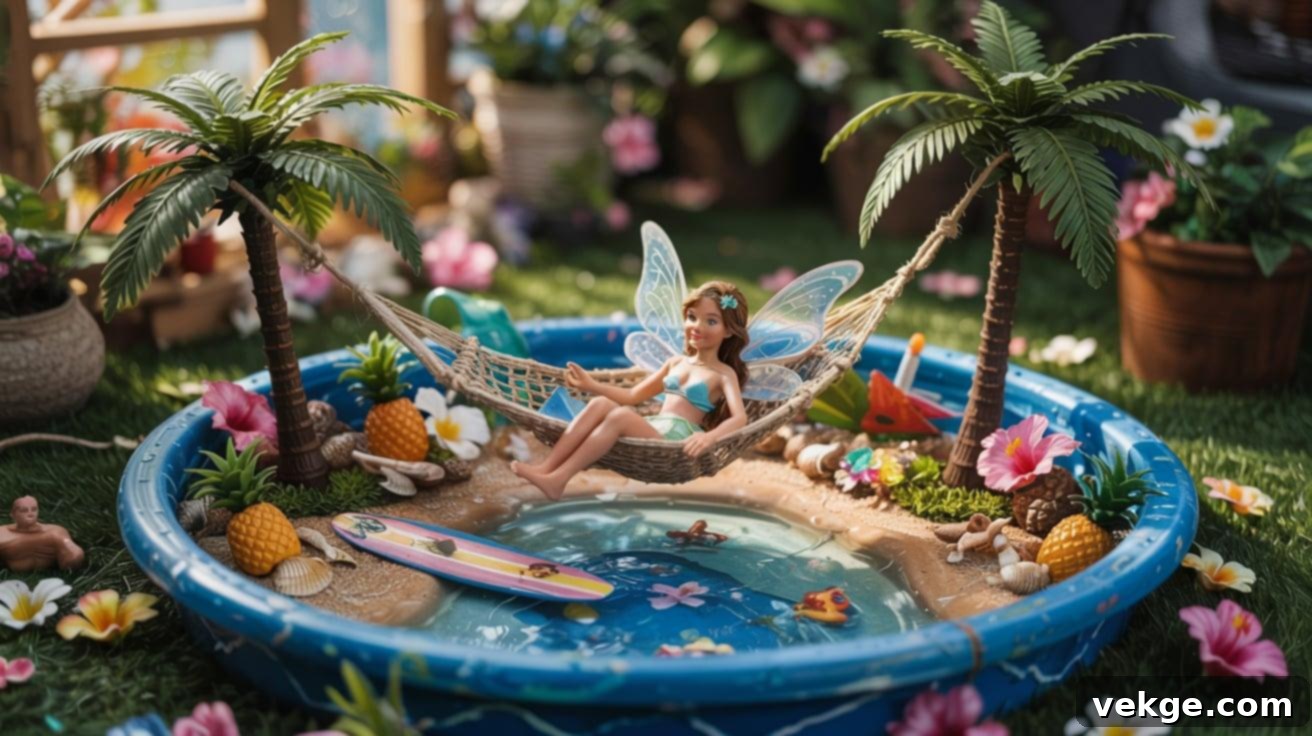
Create a vibrant, lush tropical escape for your fairies. Fill your garden with bright, exotic miniature flowers, small palm leaves, and a scattering of seashells. Add a tiny fairy relaxing in a hammock or a miniature surfboard propped against a plant. A large planter, a wide shallow bowl, or even a small kiddie pool can serve as an imaginative container. This theme is wonderful for summer displays and pairs well with miniature hibiscus plants or small palm varieties. Fake pineapples or coconuts can add a whimsical, playful touch.
23. Fairy Garden in a Drawer: Upcycled Wonderland

Give an old wooden drawer a second life as a charming fairy garden. Line the inside of the drawer with a plastic sheet to protect the wood, then add your soil, moss, and various plants. Use small stones or twigs to create distinct “rooms” or sections within the drawer. Place individual fairies or scenes in each area, effectively building a tiny house within a box. This unique garden can be displayed on a porch, a console table, or indoors, offering a creative way to reuse old furniture components.
24. Fairy Garden in Hanging Baskets: Aerial Enchantment
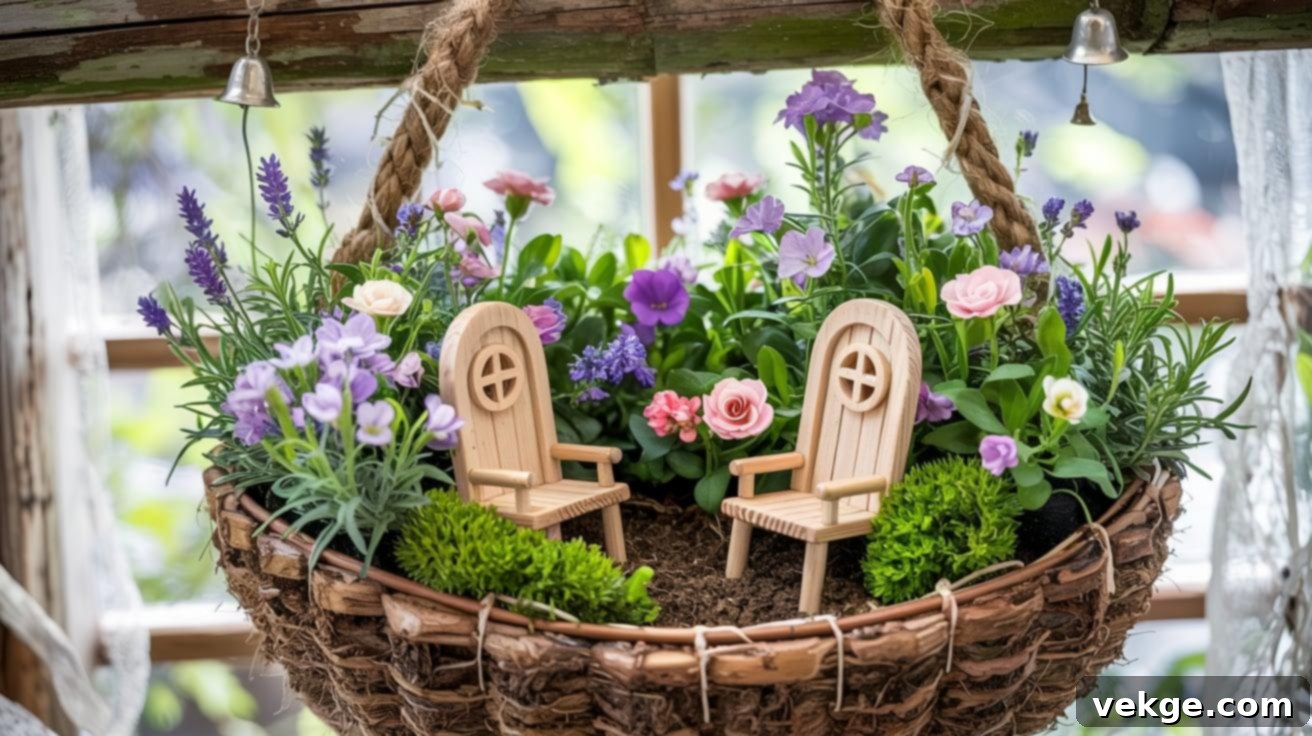
Elevate your fairy garden by creating it within hanging baskets. Utilize wire or plastic hanging baskets, filling them with moss, potting mix, and trailing flowers or plants. Incorporate miniature fairy doors, tiny chairs, and other accessories. Hang these baskets at varying heights to create a dynamic, multi-level display. This is a brilliant solution for balconies, porches, or even indoors if you have sturdy hooks. The gentle sway of the baskets in the breeze adds a lively, organic feel, and you can enhance the auditory experience with tiny wind chimes or bells.
25. Fairy Garden for Small Apartments: Compact Charm
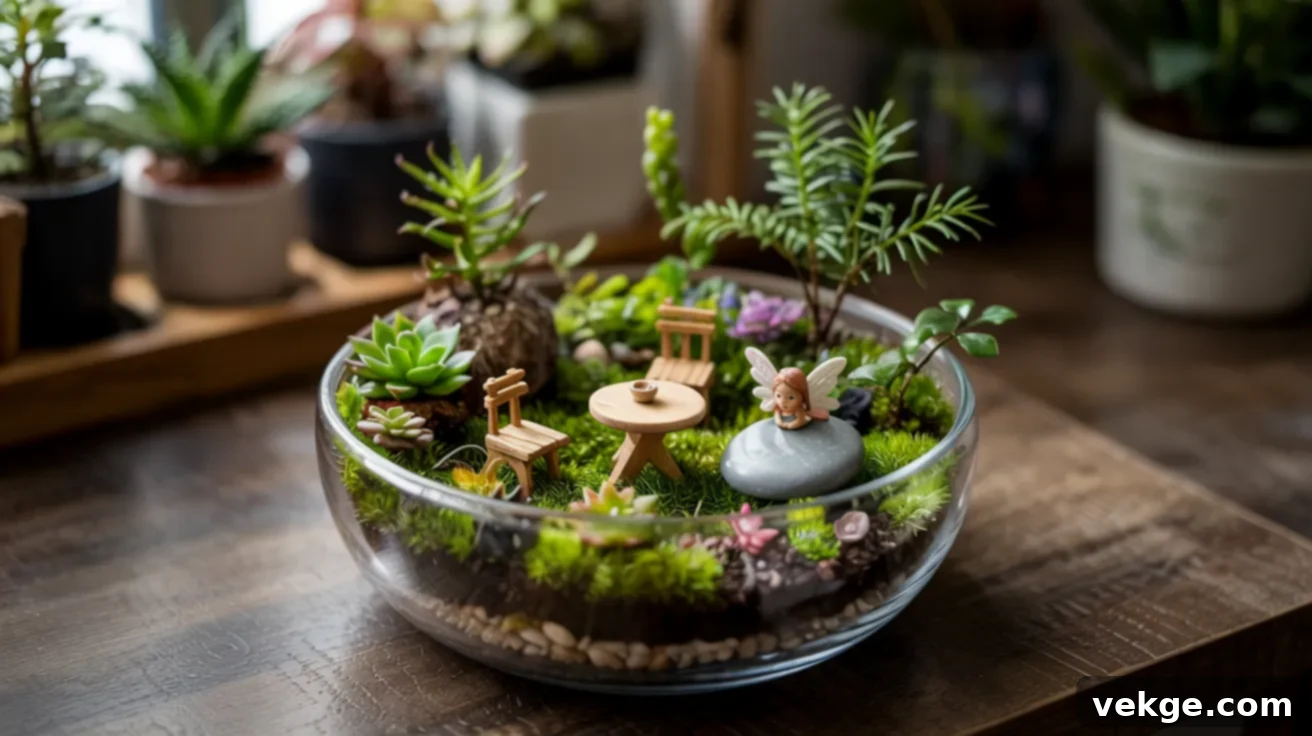
Living in a small apartment doesn’t mean you have to miss out on the magic of a fairy garden. Opt for miniature containers like small bowls, teacups, or even decorative mugs. These compact gardens can be beautifully displayed on shelves, desks, or windowsills. Use tiny plants and small-scale fairy items. Choose lightweight and safe materials that are easy to manage. These small gardens are perfect for those with no outdoor space, can be easily rearranged, and make delightful, thoughtful gifts for friends or roommates, bringing joy to any compact living area.
26. Seasonal Fairy Garden (Spring Focus): Bursting with New Life
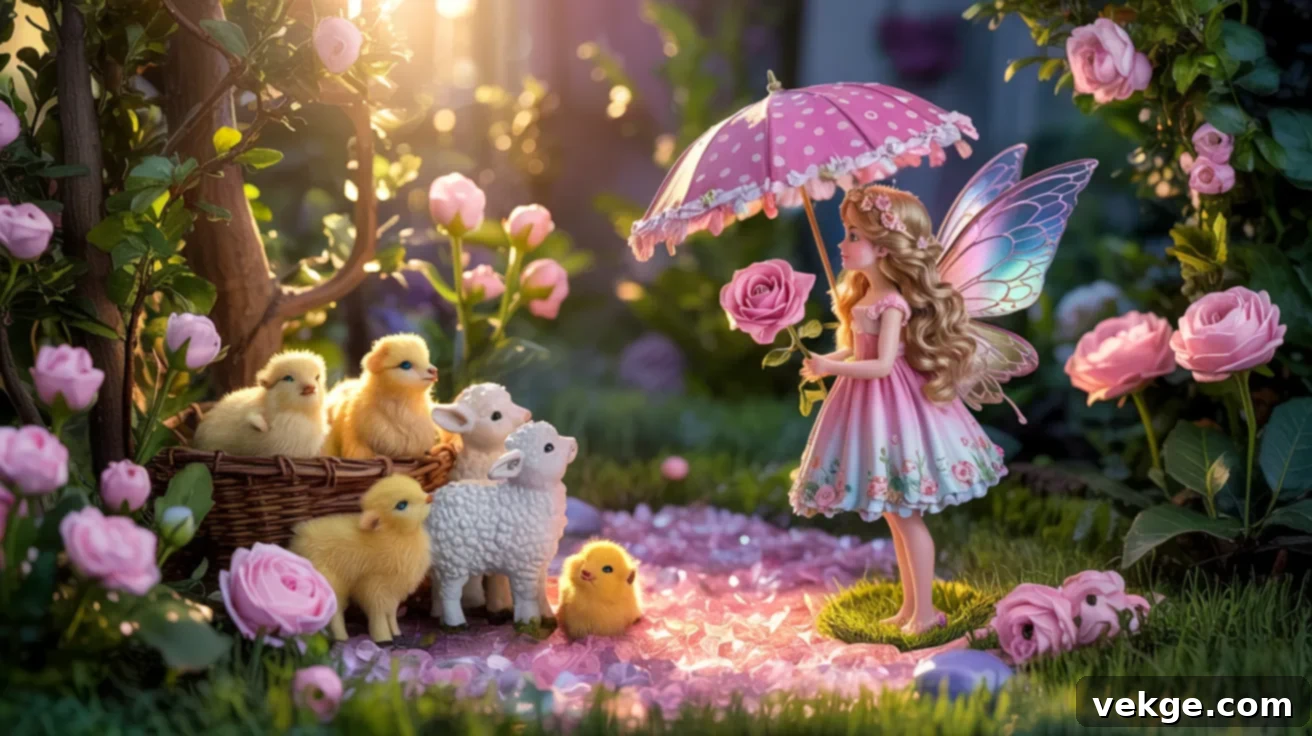
Celebrate the arrival of spring with a fairy garden that bursts with vibrant life. Incorporate bright, pastel-colored flowers, light-colored stones, and delicate butterfly figures. Add adorable baby animal figures like chicks or lambs to symbolize new beginnings. A fairy holding a miniature flower or a tiny umbrella perfectly captures the essence of spring. This type of garden looks fantastic outdoors or in a sunny window. The beauty of a seasonal garden is its ability to be refreshed and redecorated for each new season, keeping the magic ever-evolving. Use pink, yellow, and light blue elements to enhance the fresh, hopeful feel of spring.
27. Camping-Themed Fairy Garden: An Adventurous Scene
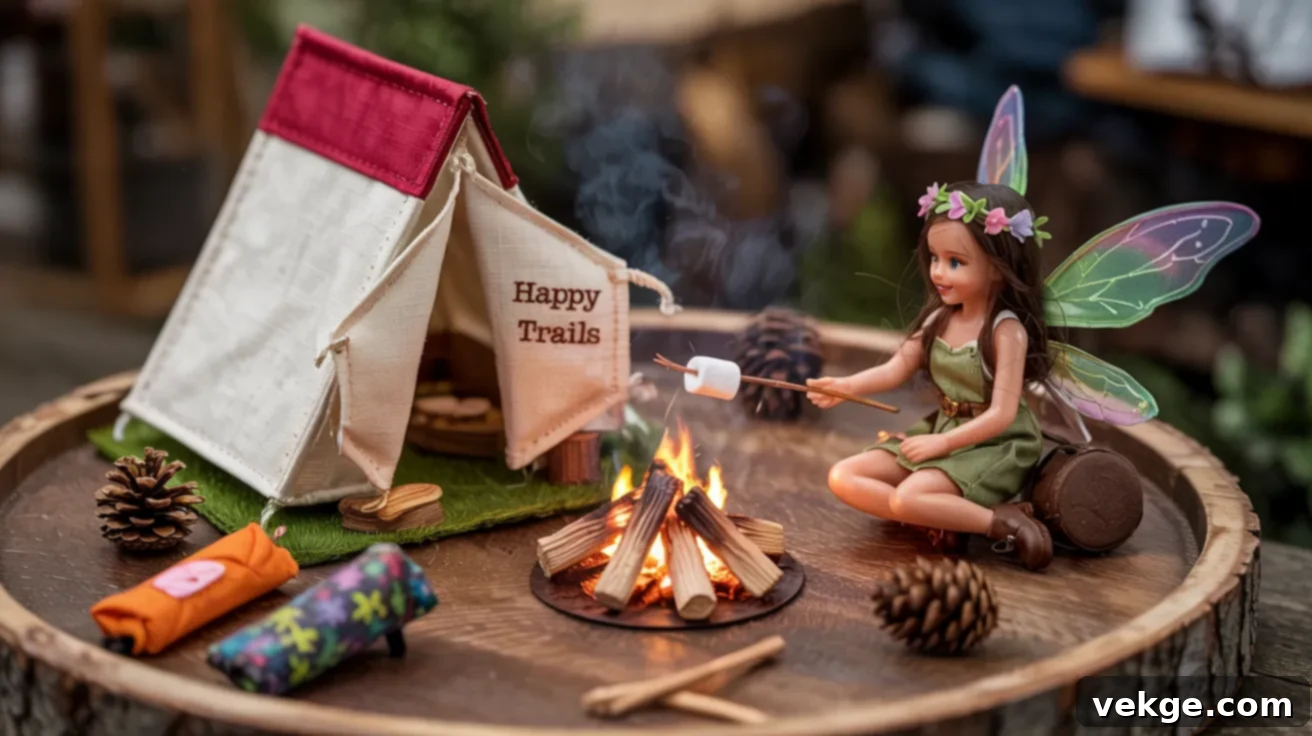
Create a cozy, adventurous miniature campsite for your fairies! Fashion a tiny tent from fabric scraps, build a faux campfire using small twigs and red/orange stones, and arrange fairy-sized logs for seating. A small tray or a shallow box makes an excellent base for this theme, perfect for summer displays. Add pinecones, tiny “marshmallows” on sticks, and miniature sleeping bags to complete the scene. This concept works equally well indoors or outdoors and is a fantastic family building project, especially appealing to kids who love the spirit of camping.
Expert Fairy Garden Layout Tips for a Harmonious Design
A well-planned layout is key to making your fairy garden feel balanced, expansive, and truly magical from every viewing angle. Consider these strategic design tips:
- Sketch Your Layout First: Before you commit to placing anything, take a few minutes to draw a simple plan or loosely arrange all your elements within the container. This pre-visualization helps you understand scale, flow, and ensures everything has a designated spot, preventing crowded or awkward arrangements.
- Layer Plant Heights for Depth: Create visual interest and a sense of realism by layering your plants and features. Position taller plants, miniature trees, or larger fairy houses towards the back of your garden. Place medium-height elements in the middle ground, and keep the shortest plants and smallest decorations in the foreground. This technique mimics natural landscapes and adds significant depth.
- Establish Clear Focal Points: Every compelling landscape has a focal point. In your fairy garden, this could be a charming fairy door, a winding path leading to a secret spot, a miniature fountain, or a glowing light. Design the surrounding elements to draw the eye towards this central feature, creating a captivating and cohesive tiny world.
- Incorporate Paths for Flow and Narrative: Winding paths are not just decorative; they guide the viewer’s eye through your garden and suggest movement. Use fine pebbles, smooth bark chips, or colored gravel to create these miniature pathways. They add a sense of journey and make the garden feel more dynamic and alive.
- Think Vertically to Maximize Space: Don’t limit your design to just the ground level. Add vertical elements like small fences, miniature fairy ladders leaning against plants, or hanging decorations. This utilizes the space above your plants, adding dimension, intrigue, and making your fairy garden feel more expansive and three-dimensional.
Maintenance and Upkeep: Keeping Your Magical World Thriving
Fairy gardens are generally low-maintenance, but a little consistent care ensures they remain vibrant and enchanting for years to come. Thoughtful upkeep is essential for preserving their charm and the health of their miniature inhabitants.
Watering: Water your fairy garden gently and sparingly, providing just enough moisture to keep the soil consistently damp but never waterlogged. A small spray bottle or a tiny watering can (even a syringe for very delicate plants) works perfectly, allowing you to direct water precisely without disturbing delicate decorations or small plants. Overwatering is a common pitfall, so always check the soil moisture before adding more water.
Pruning and Trimming: If your miniature plants start to outgrow their designated spaces or look a bit wild, give them a gentle trim. Use small scissors or tweezers to prune back any overgrown leaves or stems. Keeping the foliage and moss neat maintains a tidy and intentional overall design, ensuring the fairy garden remains perfectly scaled and aesthetically pleasing.
Cleaning and Dusting: For indoor fairy gardens, dust can accumulate on figurines, miniature houses, and plants. Take time periodically to carefully wipe down these elements. A soft brush (like a clean makeup brush) or a damp cloth is ideal for gently clearing off dust and keeping everything looking pristine and inviting.
Pest and Mold Watch: Regularly inspect your fairy garden for any signs of common issues like tiny bugs, mold, or mildew, especially in shaded or damp corners. Early detection is key. If you spot anything amiss, promptly remove affected plants or materials and gently freshen up the space. Ensuring good air circulation can help prevent many of these problems.
Replacing and Repairing: Over time, some miniature accessories might break or fade. Don’t hesitate to replace or carefully repair broken pieces to keep your garden’s charm alive. This is also a great opportunity to introduce new elements or seasonal decorations, continually refreshing your magical display. With just these few small efforts, your fairy garden will continue to inspire wonder and remain a truly magical focal point in your home or garden.
Final Thoughts: Your Journey into Miniature Magic
Creating a fairy garden is far more than just a simple weekend craft; it’s a delightful opportunity to blend nature, artistic expression, and a touch of pure magic into one captivating miniature space. You are now equipped with all the essential steps, from selecting the ideal container to adding those crucial final, personal embellishments that make your garden uniquely yours.
We sincerely hope you feel truly inspired to embark on your own fairy garden adventure, crafting a version that beautifully reflects your personal style and brings immense joy and enchantment into your home. Remember, the goal isn’t perfection, but rather the enjoyment of the creative process itself. Let your imagination lead the way, and make this tiny world genuinely your own.
Once your magical creation is complete, we’d love for you to share your masterpiece in the comments section below. Your unique fairy garden could be the perfect inspiration for someone else to begin their own journey into miniature enchantment!
For even more innovative tips and fresh ideas to keep your fairy garden looking its absolute best and to fuel your ongoing creative projects, be sure to explore other engaging blogs and resources on our website.
